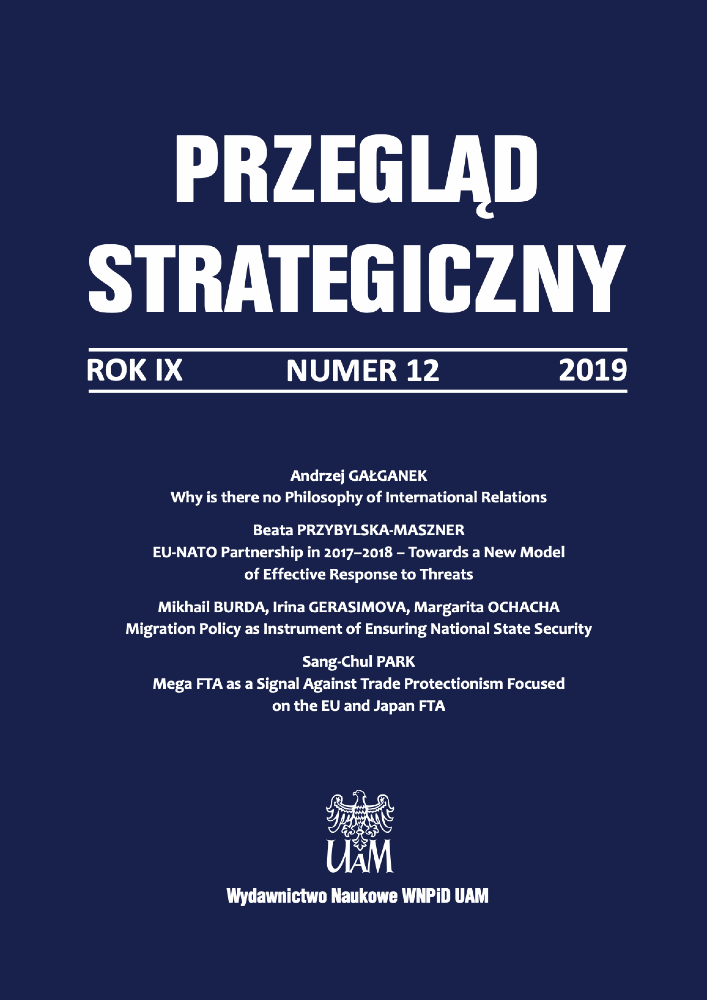Abstrakt
Zjawisko konkurencji między wielkimi mocarstwami nie jest w polityce międzynarodowej niczym nowym. Konkurencja zawsze napędzała powstawanie i upadki imperiów i państw. W XIX–XX wieku Imperium Brytyjskie zapewniło sobie światową dominację i utrzymało niekwestionowaną supremację globalną. Aby zapewnić dalszą globalną dominację Wielkiej Brytanii, w 1904 roku Sir Halford Mackinder zadziwił świat swoją teorią „heartlandu”, która pozostaje jedną z najczęściej dyskutowanych teorii geopolitycznych. Zdając sobie sprawę z głębokiej krytyki, jakiej przez kilka dziesięcioleci poddawano teorię Mackindera, artykuł wykorzystuje ją jednak w kontekście współczesnego międzynarodowego środowiska politycznego, ze szczególnym uwzględnieniem wydarzeń w rejonie Oceanu Indyjskiego, Zatoki Perskiej i Morza Arabskiego. Dlatego też analiza koncentruje się tutaj na możliwościach zastosowania teorii i implikacjach wynikających z racjonalizacji geograficznej Mackindera w formułowaniu polityki zagranicznej wokół tego, co artykuł uważa za współcześnie kluczowy obszar (pivot area) – Ocean Indyjski. Teoretyczna interpretacja tezy Mackindera dowodzi, że Ocean Indyjski i sąsiednie korytarze morskie i cieśniny są „kluczowymi obszarami”, których siła stymuluje konkurencję między potęgami regionalnymi i światowymi. Nowe „obszary kluczowe” są niezwykle bogate w zasoby naturalne i stanowią główne szlaki energetyczne, od których zależą gospodarki globalne. Artykuł kończy konkluzja, że w nowym regionie kluczowym wykluwa się kompleksowa konkurencja energetyczna (complex power competition (CPC)).
Bibliografia
Afridi J., Bajoria J. (2010), China-Pakistan Relations, “Council on Foreign Relations”, https://www.cfr.org/backgrounder/china-pakistan-relations (28.10.2019).
Ahmad N. (1981), Sino-Pakistan Relations (1971–1981), “Pakistan Horizon”, Vol. 34, No. 3, http://www.jstor.org/ stable/41393854 (28.10.2019).
Ahmar M. (1983), Politics of Superpower Rivalry in the Indian Ocean, “Pakistan Horizon”, Vol. 36, No. 1, https://www.jstor.org/stable/41394719 (28.10.2019).
Albert E. (2016), Competition in the Indian Ocean, “Council on Foreign Relations”, https://www.cfr.org/backgrounder/competition-indian-ocean (28.10.2019).
Barrington L., Wroughton L., U.S. blames Iran for tanker attacks in Gulf of Oman, Iran rejects assertion, “Reuters”, https://www.reuters.com/article/us-mideast-tanker/oil-tanker-attacks-in-gulf-of-oman-fuel-security-oil-supply-fears-idUSKCN1TE0OI (13.06.2019).
Bassin M., Aksenov K. E. (2006), Mackinder and the Heartland Theory in Post-Soviet Geopolitical Discourse, “Geopolitics”, Vol. 11, No. 1, https://doi.org/10.1080/1465004050052412 (28.10.2019).
Bederman D. (2008), Globalization and International Law, Palgrave Macmillan, New York.
Brewster D. (2010), An Indian Sphere of Influence in the Indian Ocean?, “Security Challenges”, Vol. 6, No. 3, https://www.jstor.org/stable/26459796 (28.10.2019).
Chaudhury R. R. (2018), India and the Gulf region: building strategic partnerships, “International Institute for Strategic Studies”, https://www.iiss.org/blogs/analysis/2018/08/india-gulf-stra-tegic-partnerships (28.10.2019).
Chaudhury R. R. (2018), India’s evolving partnership with the Gulf region, “World Economic Forum”, https://www.weforum.org/agenda/2018/10/india-s-evolving-partnership-with-the-gulf-region/ (28.10.2019).
Clover C. (1999), Dreams of the Eurasian Heartland: The Re-emergence of Geopolitics, “Foreign Affairs”, Vol. 78, No. 2.
Cohen S. B. (1963), Geography and politics in a world divided, Random House, New York.
Dee M. (2015), The European Union in a Multipolar World: World Trade, Global Governance and the Case of the WTO, Palgrave Macmillan, New York.
Dowdy W. L., Trood R. B. (1983), The Indian Ocean: An Emerging Geostrategic Region, “International Journal”, Vol. 38, No. 3, https://www.jstor.org/stable/40202160 (28.10.2019).
From defence to space, Oman, India sign a clutch of MoUs, “Times of Oman”, https://timesofoman.com/article/127976 (11.02.2018).
Government of Oman (2016), A Brief of Vision for Oman’s Economy – 2020: Long-Term Development Strategy (1996–2020), Ministry of National Economy, https://www.scp.gov.om/PDF/NinthFiveYearPlan.docx (28.10.2019).
Hall A. R. (1955), Mackinder and the Course of Events, “Annals of the Association of American Geographers”, Vol. 45, No. 2.
Jaishankar D. (2016), Indian Ocean region: A pivot for India’s growth, “Brookings”, https://www.brookings.edu/opinions/indian-ocean-region-a-pivot-for-indias-growth/ (28.10.2019).
Jayaramu P. S. (1986), Indian Ocean as a Zone of Peace: Problems and Perspectives, “The Indian Journal of Political Science”, Vol. 47, No. 2, https://www.jstor.org/stable/41855848 (28.10.2019).
Katzma K. (2016), Oman: Reform, Security, and U.S. Policy, Congressional Research Service, https://fas.org/sgp/crs/mideast/RS21534.pdf (28.10.2019).
Ki-moon B. (2016), Maritime Transport Is ‘Backbone of Global Trade and the Global Economy’, Says Secretary-General in Message for International Day, “UN Press Release”, SG/SM/18129-OBV/1663-SAG/486, https://www.un.org/press/en/2016/sgsm18129.doc.html (22.09.2016).
Maritime Doctrine of Russian Federation 2020, approved by the decree of Vladimir Putin, President Russian Federation, Pr-1387 (2001), Centre for Strategic Assessment and Forecasts, http://csef.ru/en/politica-i-geopolitica/510/morskaya-doktrina-rossijskoj-federaczii-na-period-do-2020-goda-7984 (28.10.2019).
Mackinder H. J. (1904). The Geographical Pivot of History, “The Geographical Journal”, Vol. 23, No. 4.
Mackinder H. J. (1942), Democratic Ideals and Reality: A Study in the Politics of Reconstruction, Constable Publishers, London.
Mackinder H. J. (1943). The Round World and the Winning of the Peace, “Foreign Affairs”, Vol. 21, No. 4, https://www.jstor.org/stable/2002978 (28.10.2019).
Mathew J., India reports robust growth in trade with Gulf region, “Arabian Business”, https://www.arabianbusiness.com/politics-economics/419185-india-reports-robust-trade-growth-with-gulf-region (1.05.2019).
Meinig D. W. (1956), Heartland and Rimland in Eurasian History, “The Western Political Quarterly”, Vol. 9, No. 3.
Minister urges Iran to stop attacks in Gulf of Oman, “BBC”, https://www.bbc.com/news/uk-48738717 (24.06.2019).
OECD (2010), Globalisation, Transport and the Environment, “OECD Publishing”.
Osiewicz P. (2018), The Belt and Road Initiative (BRI): Implications for Iran-China Relations, “Przegląd Strategiczny”, Vol. 8, No. 2.
Panda D. (1997), The United States and China: Towards A Rapprochement, “Indian Journal of Asian Affairs”, Vol. 10, No. 2.
Pandya A. A., Herbert-Burns R., Kobayashi J. (2011), Maritime Commerce and Security: The Indian Ocean, Stimson Centre, Washington DC.
Pant H. V. (2009), India in the Indian Ocean: Growing Mismatch between Ambitions and Capabilities, “Pacific Affairs”, Vol. 82, No. 2.
Scott M., Alcenat W. (2008), Revisiting the Pivot: The Influence of Heartland Theory in Great Power Politics, “Macalester College”, http://www.creighton.edu/fileadmin/user/CCAS/departments/PoliticalScience/MVJ/docs/The_Pivot_-_Alcenat_and_Scott.pdf (28.10.2019).
Sidaway J. (2001), Geopolitics: Twentieth Century Spectre, “Geographical Association”, Vol. 86, No. 3, https://www.jstor.org/stable/40573579?seq=1#metadata_info_tab_contents (28.10.2019).
Taylor P., Flint C. (2000), Political Geography: World –Economy, Nation State and Locality, Pearson Education, Delhi.
The Asia-Pacific Maritime Security Strategy: Achieving U.S. National Security Objectives in a Changing Environment (2015), “US Department of Defense”, https://dod.defense.gov/Portals/1/Documents/pubs/NDAA%20A-P_Maritime_SecuritY_Strategy-08142015-1300-FINALFORMAT.PDF (28.10.2019).
UK and Oman sign historic Joint Defence Agreement, “Ministry of Defence”, https://www.gov.uk/government/news/uk-and-oman-sign-historic-joint-defence-agreement (21.02.2019).
UK Secures Naval Base in Oman, “The Maritime Executive”, https://www.maritime-executive.com/article/uk-secures-naval-base-in-oman (21.02.2019).
US-Sri Lanka naval exercise at port managed by China, “The Economic Times”, https://economictimes.indiatimes.com/news/defence/us-sri-lanka-naval-exercise-at-port-managed-by-china/articleshow/68986125.cms?from=mdr&utm_source=contentofinterest&utm_medium=text&utm_campaign=cppst (22.04.2019).
Venier P. (2004), The Geographical Pivot of History and Early Twentieth Century Geopolitical Culture, “The Geographical Journal”, Vol. 170, No. 4.
Weigert H. W. (1945–46), Mackinder’s Heartland, “The American Scholar”, Vol. 15, No. 1.
Xi L., Yuanyong Y., Spotlight: China, Oman establish industrial park to boost bilateral cooperation, “Xinhuanet”, http://www.xinhuanet.com/english/2018-12/19/c_137683272.html (19.12.2018).

